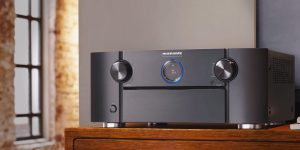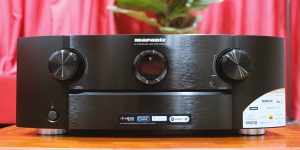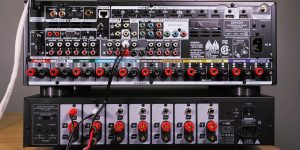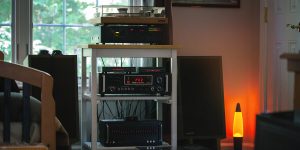You’re about to upgrade your home system, and I know you’re thinking, “AV receivers are very expensive.” In my article, I’ll prove that you don’t have to break the bank to make an upgrade, and I’ll tell you how to find the best AV receiver under $1,000. I’ve put together some great models for you in this price range, and they’ll make you want to purchase them immediately. But remember, it’s not about the price but the experience. So, buckle up and get ready to embark on this exciting journey.

AV receivers under $1000 comparison table
| Name | Channels | Power output | HDMI in/out | Bluetooth/Wi-Fi | Review |
|---|---|---|---|---|---|
| Marantz SR5015 best overall | 7.2 | 100W/8 Ohms, 140W/6 Ohms | 6/2 | yes/yes | Review |
| Yamaha RX-V6A also a great choice | 7.2 | 100W/8 Ohms | 7/1 | yes/yes | Review |
| Onkyo TX-NR7100 best 9.2 receiver | 9.2 | 100W/8 Ohms | 7/2 | yes/no | Review |
Top picks for best AV receiver under $1000
Marantz SR5015 – best overall

The main contender for first place in the table is the Marantz SR5015. While I’m not discounting the brand’s quality, the design is impressive and looks premium. However, I wouldn’t say I like their round screen, which makes it hard to read anything from a great distance.
So, the Marantz SR5015 is a 7.2-channel AV receiver with Dolby Atmos and DTS:X support. With 100W (8 Ohm, 20Hz – 20kHz, 0.08% THD, 2 ch), a wide range of connectivity options, and Marantz’s outstanding sound quality, the SR5015 could be the Atmos receiver you’ve been looking for under one thousand dollars.

With HDMI 2.1 ports (2 HDMI eARC outputs), you can connect various devices such as game consoles, Blu-ray players, streaming devices, and a turntable. They also support 8K/60Hz and 4K/120Hz video streaming and HDR10/10+, Dolby Vision, and HLG formats. Moreover, you can enhance video to 4K or even 8K with the up-scaling option.
The Wi-Fi and Bluetooth wireless connections and compatibility with streaming services (AirPlay 2, Spotify, TuneIn) and voice assistants. This receiver also has built-in HEOS for multi-room audio and easy playback of streams from various sources.

Setting up the receiver was easy with the Audyssey MultEQ XT32. When it came to movie playback, I had a thrilling experience. The sound of the flying overhead of “Fast and Furious” demonstrated the SR5015’s ability to create a convincing 3D soundscape. When listening to Adele’s “Rolling in the Deep,” the singer’s vocals were delivered with impressive clarity and emotion.
Having spent time with the Marantz SR5015, I can confidently say this is the best AV receiver under $1000. If you are in the market for a home theater system upgrade, the Marantz SR5015 should definitely be on your radar.
Specifications of Marantz SR5015
- Channels: 7.2.
- Output power: 100W/8 Ohms, 140W/6 Ohms.
- HDMI inputs/outputs: 6/2.
- Surround sound
- Dolby features: Dolby TrueHD, Dolby Atmos Height Virtualizer, Dolby Atmos, Dolby Surround.
- DTS features: DTS HD Master, DTS:X, DTS Neural:X, DTS Virtual:X.
- Video
- Video functions: 4K/120Hz, 8K/60Hz pass-through, upscaling to 8K.
- Video support: HDMI ARC, HDMI eARC, HDMI CEC, HDCP2.3, HLG, HDR10, HDR10+, Dynamic HDR, Dolby Vision.
- Bluetooth/Wi-Fi: yes/yes.
- Streaming service: AirPlay2, Spotify, Deezer, Tidal, Pandora, SiriusXM, Napster, SoundCloud, Amazon Music HD, TuneIn.
Pros
- Supports high-quality 8K video.
- 8K up-scaling option.
- Built-in HEOS system for multi-room audio and streaming.
- Support for modern surround sound formats.
Cons
- The front panel illuminator can be difficult to read from a distance.
YAMAHA RX-V6A – also a great choice
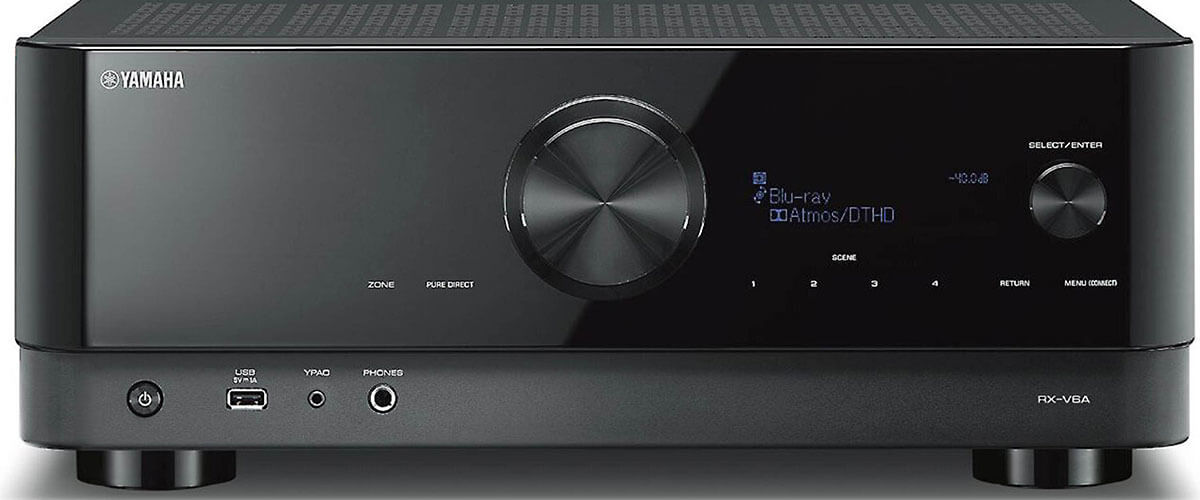
The Yamaha RX-V6A is also a great choice for those looking for quality, functionality, and affordability. It is not much different from my review leader. The brand features are more likely to come to the fore here than any unique features of these models. But still, I will try to compare them.
The Yamaha RX-V6A has one more HDMI input but only one output. They all support CEC and HDCP 2.3, as well as eARC for the output port. So you have HDR10+, HLG, and Dolby Vision video available at 8K/60Hz or 4K/120Hz. But the passthrough feature here is only for 4K video, unlike the SR5015.
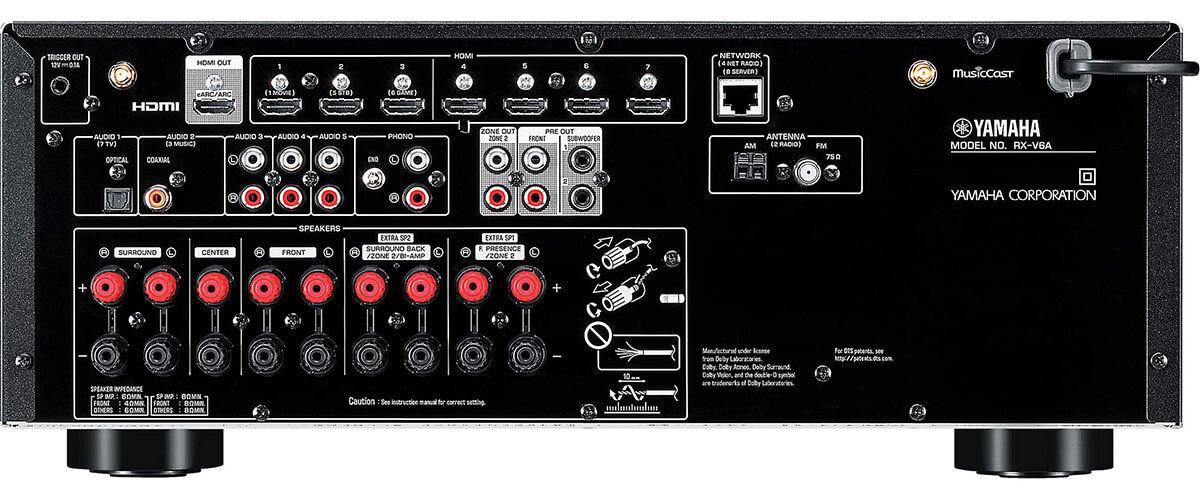
Also, like the Marantz, there’s Wi-Fi and Bluetooth for pairing with streaming services and voice assistants, and built-in MusicCast multi-room technology will help stream them to different areas of your home.
The RX-V6A has identical 100W Marantz power (8 Ohm, 20Hz – 20kHz, 0.06%, 2 ch), the finest THD value of those on my list, and is available with Dolby Atmos and DTS:X surround sound. But the main value lies in the Virtual Cinema DSP technology, so you can use these formats even if you don’t have special overhead speakers. Instead, the sound will be virtually routed upwards, creating the illusion of high-altitude broadcasting.
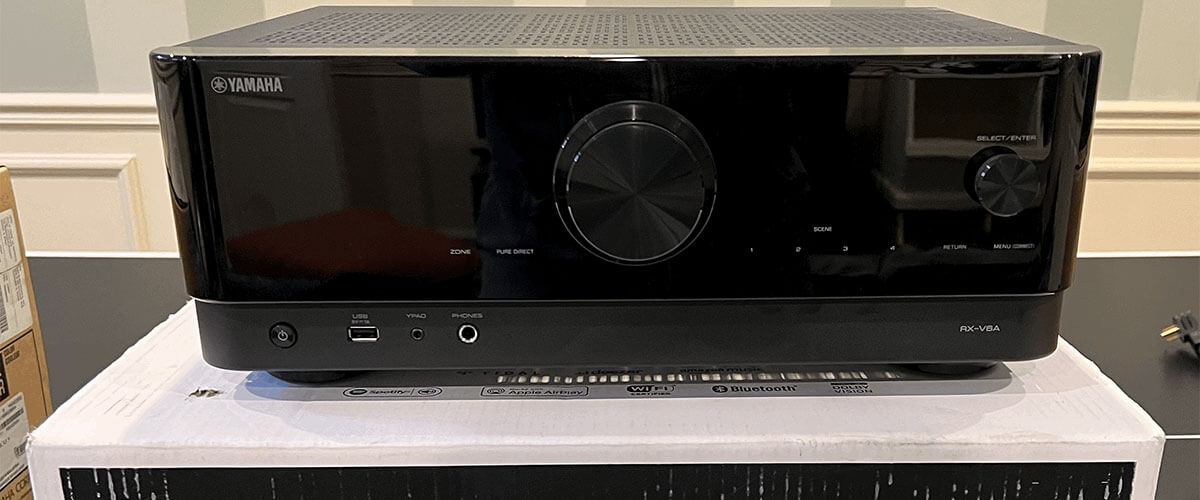
I like Yamaha YPAO autocalibration because it’s convenient and easy, and I often test receivers, so I understand the point. This time I chose Finch the film. I really liked the sound of the ominous storm, the robot’s movements also sounded impressively realistic, and the dialogue listened well with the background of the car driving. Fleetwood Mac’s “Go Your Own Way” showcased the receiver’s ability to handle complex instrumental compositions, though it is worth noting the somewhat cold Yamaha specificity inherent in all brand receivers.
Yamaha RX-V6A is an excellent home theater amplifier in its price range, with a great feature set that allows you to combine old and new. And I give it the title of second best audio video receiver under $1000.
Specifications of YAMAHA RX-V6A
- Channels: 7.2.
- Output power: 100W/8 Ohms.
- HDMI inputs/outputs: 7/1.
- Surround sound
- Dolby features: Dolby TrueHD, Dolby Atmos Height Virtualizer, Dolby Digital Plus, Dolby Atmos, Dolby Surround.
- DTS features: DTS HD Master, DTS:X.
- Video
- Video functions: 4K/120Hz, 8K/60Hz pass-through, upscaling to 4K.
- Video support: HDMI ARC, HDMI eARC, HDMI CEC, HDCP2.3, HLG, HDR10, HDR10+, Dolby Vision.
- Bluetooth/Wi-Fi: yes/yes.
- Streaming service: AirPlay2, Spotify, Deezer, Tidal, Pandora, SiriusXM, Napster, SoundCloud, Amazon Music HD, TuneIn.
Pros
- Connection ports allow you to assemble a system of old and new equipment.
- The THD value of 0.06% is the finest of those on my list.
- Supports the latest surround sound formats.
- Built-in Virtual Cinema DSP technology for surround sound simulation.
Cons
- No passthrough feature for 8K.
- Cold sound, not the most appropriate for classic rock tracks.
Onkyo TX-NR7100 – best 9.2 receiver under 1000
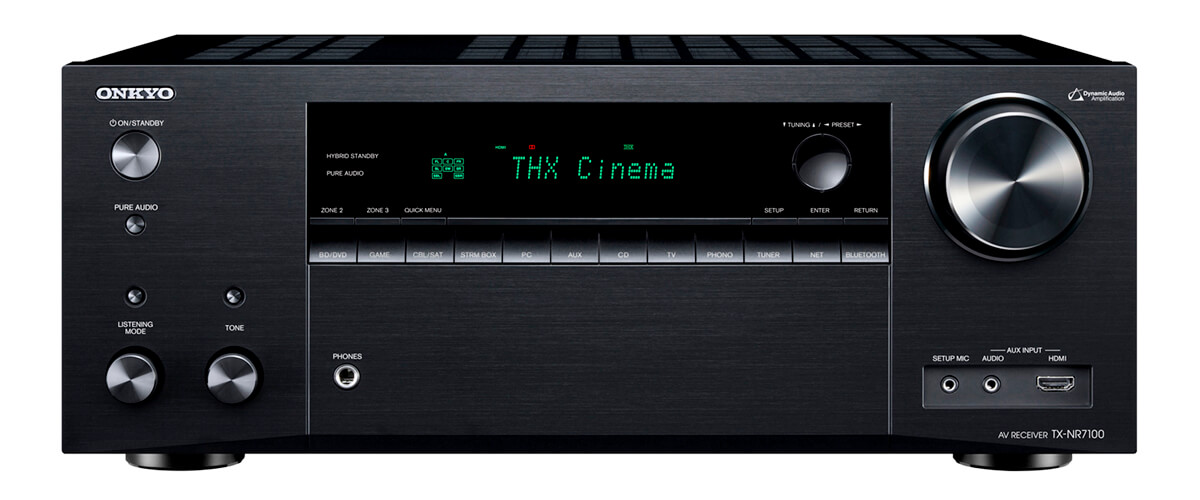
Onkyo released its 9.2-channel TX-NR7100 in 2021. And it’s the only AVR with this configuration in our chart, which sets it apart from its predecessors and means you can build a 5.2.4 or 7.2.2 system to your liking.
Its power is the same as Marantz and Yamaha described above, i.e., 100W per channel (8 Ohm, 20Hz – 20kHz, 0.08% THD, 2 ch), and it is quite suitable for large-size rooms.
But it has more HDMI ports (7/2), although, with them, you get all the same features: HDCP 2.3, 4K/120Hz, 8K/60Hz, VRR, and ALLM for gamers, ensuring compatibility with the latest video and audio formats, which include 4K/120Hz and 8K/60Hz passthrough as well as HDR10, HLG, and Dolby Vision.
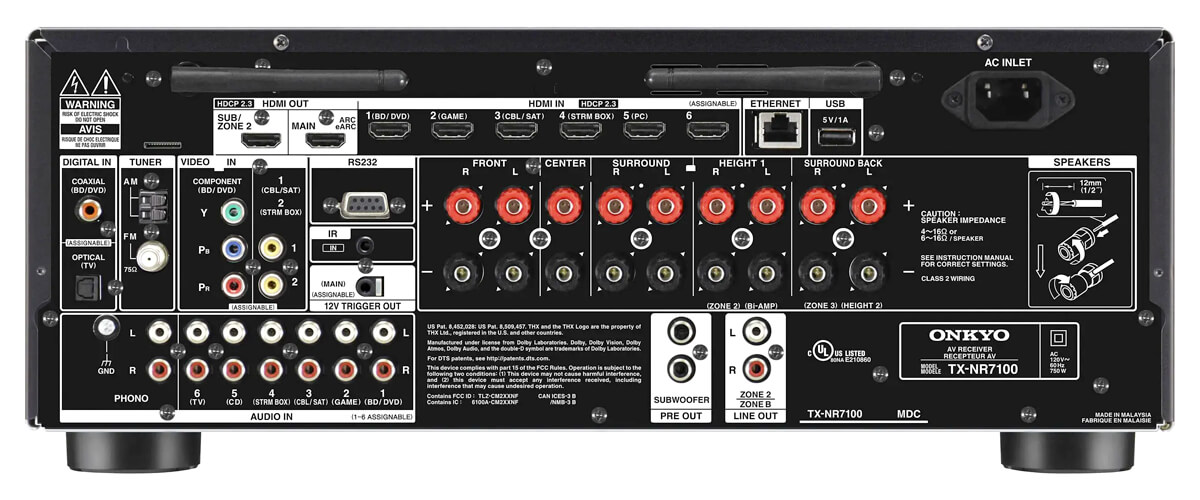
The other inputs and outputs are about identical to the competition. There is wireless connectivity as well. But I really like the built-in streaming services Spotify, TIDAL, Deezer, TuneIn, and Pandora. As I made sure in my testing, they worked perfectly. But to control your voice, you’ll have to shell out some money, my dears. Unfortunately, the device for this is sold separately.
So, we got surround sound for Dolby Atmos and DTS:X, but the TX-NR7100 also features THX Certified Select Dynamic Audio Amplification and IMAX Enhanced technologies for an even more impressive experience. Finally, there’s also the simple AccuEQ Advance auto-calibration with AccuReflex and 3-Zone audio broadcasting.
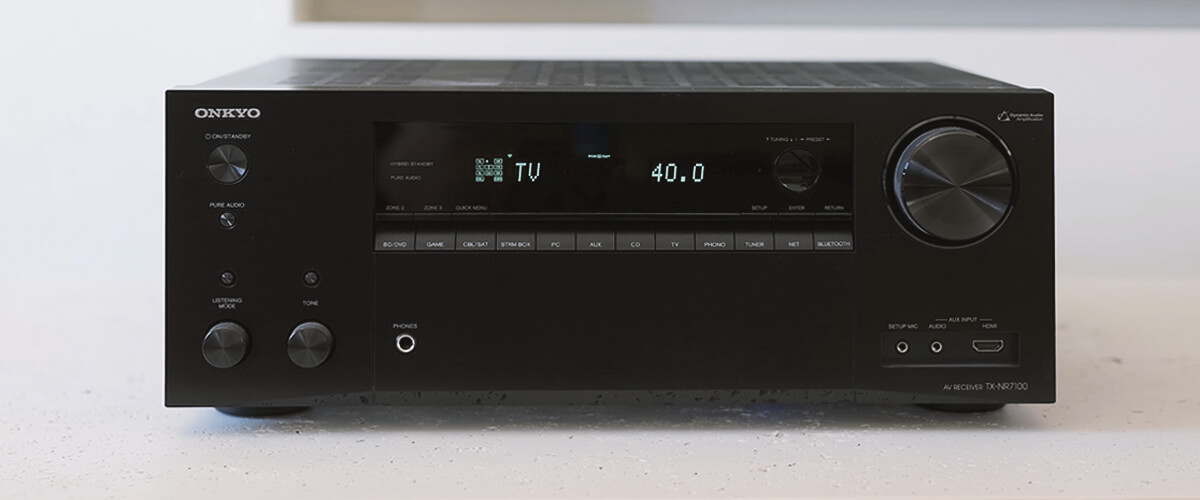
To test the Onkyo, I turned on RoboCop and was pleasantly impressed with the crisp and clear soundscapes. The action effects of the gunfights didn’t blend into a splashy mess but corresponded very clearly to the picture on the screen. I listened to the music on the built-in Spotify, and the indie-rock selection I adored sounded in the 2 Zones with the same precision and clarity.
Needless to say, I frankly consider the Onkyo TX-NR7100 to be the best 9.2 receiver under $1000. It’s a great choice for those with many rooms in the house where they can stream their favorite tracks or spend an evening with the family watching high-quality content.
Specifications of Onkyo TX-NR7100
- Channels: 9.2.
- Output power: 100W/8 Ohms.
- HDMI inputs/outputs: 7/2.
- Surround sound
- Dolby features: Dolby TrueHD, Dolby Atmos Height Virtualizer, Dolby Atmos, Dolby Surround.
- DTS features: DTS HD Master, DTS:X, DTS Neural:X.
- IMAX Enhanced.
- Video
- Video functions: 4K/120Hz, 8K/60Hz pass-through, upscaling to 8K.
- Video support: HDMI ARC, HDMI eARC, HDCP2.3, HLG, HDR10, HDR10+, Dolby Vision.
- Bluetooth/Wi-Fi: yes/yes.
- Streaming service: AirPlay2, Spotify, Deezer, Tidal, Pandora, SiriusXM, Napster, SoundCloud, Amazon Music HD, TuneIn.
Pros
- The only one on the list has 9.2 channels.
- Equipped with THX Certified Select Dynamic Audio Amplification and IMAX Enhanced technologies.
- Broadcast audio to 3 Zones.
Cons
- A separate device must be purchased to work with voice assistants.
Denon AVR-S970H
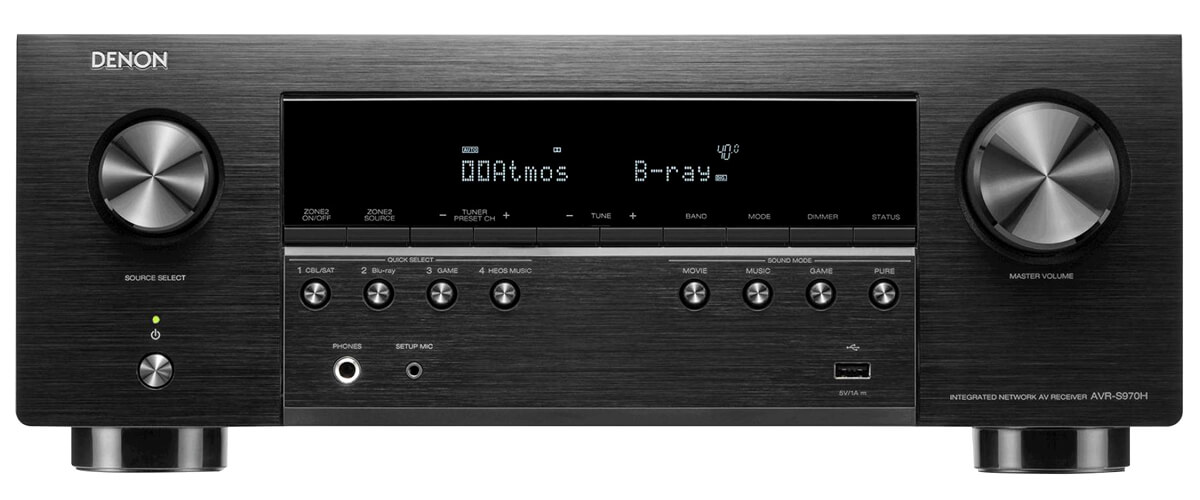
The next home theater receiver under $1000 in my rating is the Denon AVR-S970H, which, like the Marantz SR5015, has a 7.2 configuration and can play DTS:X and Dolby Atmos surround sound formats.
Although the AVR-S970H is slightly less powerful at 90W (8 Ohms, 20Hz – 20kHz, 0.08%, 2ch), it’s still productive enough for medium and large spaces. In any case, for receivers in this category, I don’t recommend turning the volume to the maximum; the sound will lose clarity. You can find here two Multi-Room zones, built-in HEOS Wireless Multi-Room technology, wireless Wi-Fi, and Bluetooth support for streaming services and voice assistants. All in all, for those with a large family with different preferences, this is the one for you.
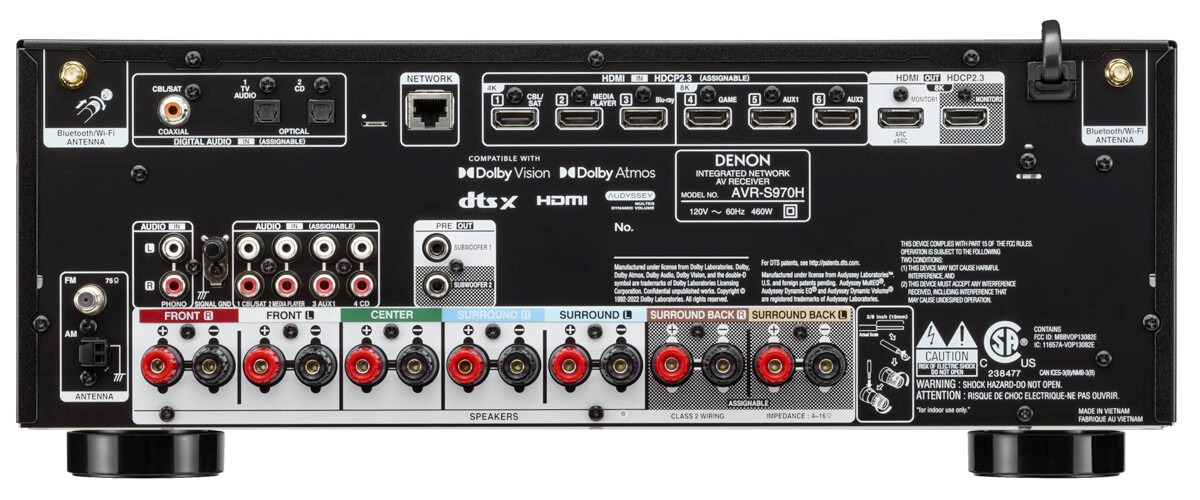
AVR-S970H supports the same video formats and resolutions, so the 8K/60Hz and HDR content is available to you here, and I will not repeat myself but proceed to describe the experience.
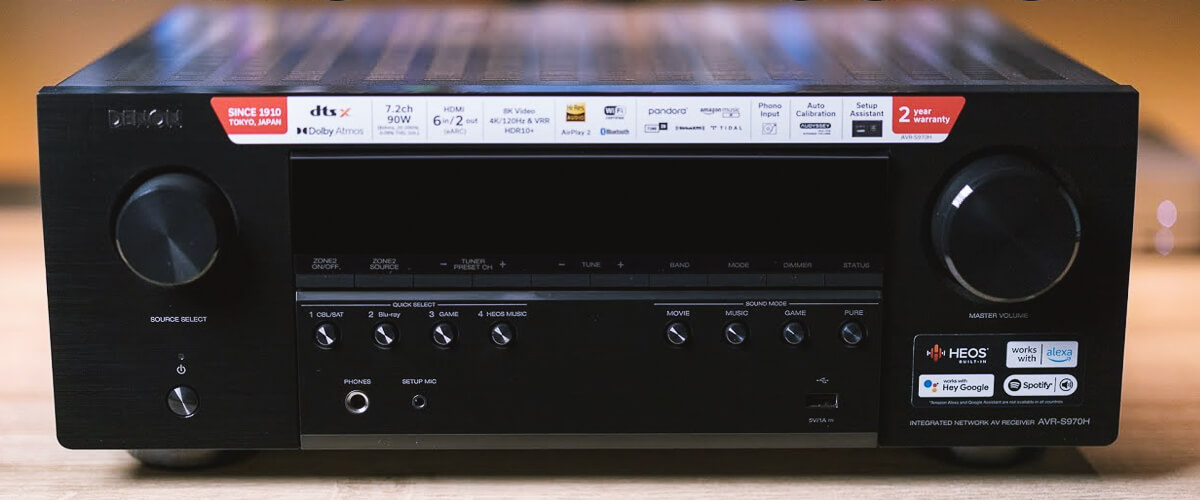
I will not hide that I am a fan of Denon equipment. I love the authentic warmth of its sound, so I chose A.I. Artificial Intelligence because I don’t know a more heartwarming movie with powerful sound scenes. My speakers produced sounds worthy of the more expensive models during the arena scene. Of course, in the case of Denon, I always try vinyl, which sounds as natural as possible with this particular brand, and my old Ace of Base record brought me back to my childhood, giving me a 90s beat in all its glory.
In my opinion, the Denon AVR-S970H is the top-sounding 4K audiophile receiver under $1000. It will suit fans of analog sound, and its capabilities will meet the needs of everyone in the family.
Specifications of Denon AVR-S970H
- Channels: 7.2.
- Output power: 90W/8 Ohms, 125W/6 Ohms.
- HDMI inputs/outputs: 6/2.
- Surround sound
- Dolby features: Dolby TrueHD, Dolby Atmos Height Virtualizer, Dolby Atmos, Dolby Surround, Dolby Atmos Music.
- DTS features: DTS HD Master, DTS:X, DTS Virtual:X, DTS Neural:X.
- Video
- Video functions: 4K/120Hz, 8K/60Hz pass-through, upscaling to 8K.
- Video support: HDMI ARC, HDMI eARC, HDCP2.3, HLG, HDR10, HDR10+, Dynamic HDR, Dolby Vision.
- Bluetooth/Wi-Fi: yes/yes.
- Streaming service: AirPlay2, Spotify, Deezer, Tidal, Pandora, SiriusXM, Napster, SoundCloud, Amazon Music HD, TuneIn.
Pros
- The built-in native HEOS system for multi-zone broadcasting works flawlessly with wireless speakers.
- Suitable for gamers.
- Excellent warm vinyl performance.
Cons
- Slightly less power than competitors.
- Inferior to other models in the number of HDMI ports.
Sony STR-AN1000
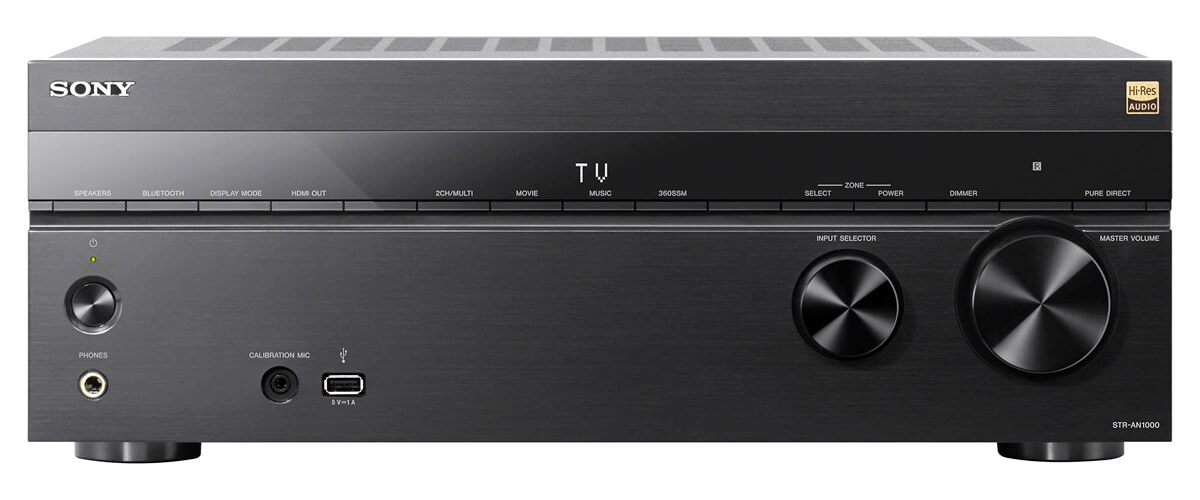
Meet the newcomer! The Sony STR-AN1000 AV receiver 2023 was released recently, and I can’t wait to tell you about my impressions.
I won’t repeat myself by listing the connectivity and available video formats; they are identical to those in its predecessors (including IMAX Enhanced and 2-Zone video streaming). But there is no phono input in the receiver, so record lovers will have to connect an external preamplifier.
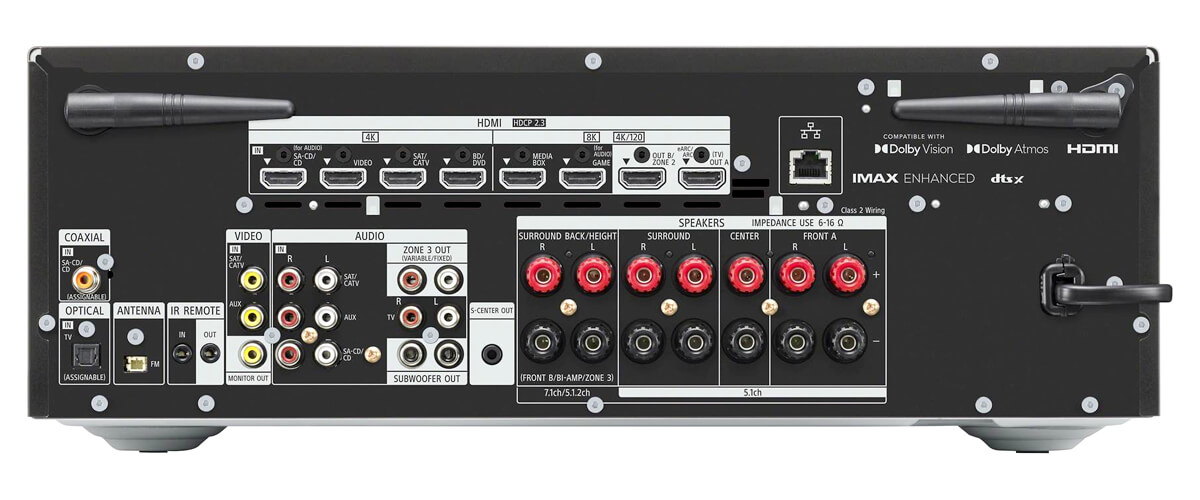
As for sound, Sony is also a modern device and is not inferior to the previous competitors, offering us 165W (6 ohms, 1kHz, 0.9%, 1ch) for listening to DTS:X and Dolby Atmos surround sound as well as earlier versions. And its unique 360 Spatial Sound Mapping technology will deliver concert sound to the home. But an even cooler feature is the near-high-quality enhancement with DSEE Ultimate, which simulates the sound of a studio recording as it uses AI-based technology.
Wireless capabilities are already standard on this chart – WI-FI and Bluetooth are compatible with AirPlay, Spotify, and Google Assistant. The device also has a built-in Chromecast, is Sonos compatible, and streams audio for 3 Zones.
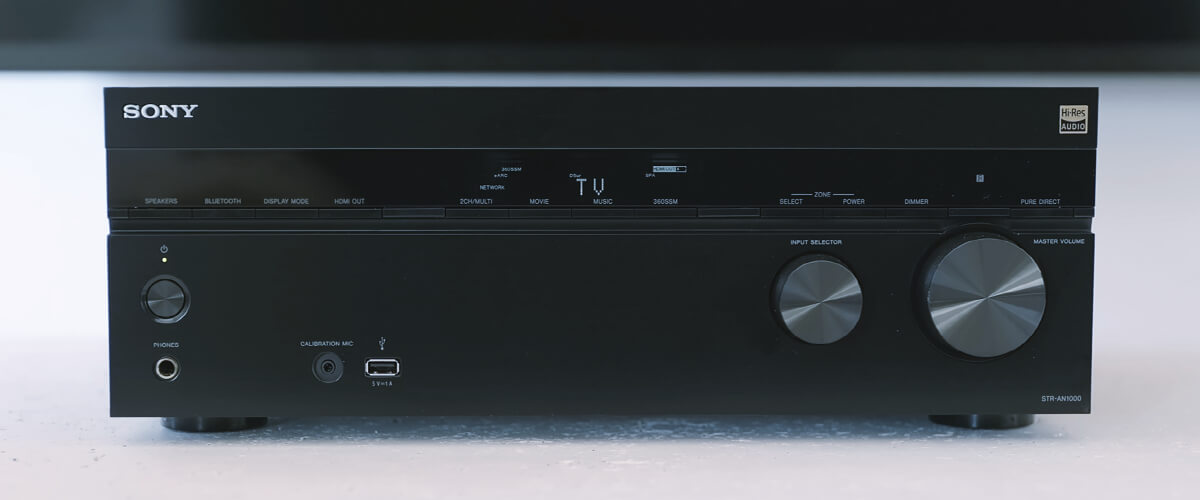
Sony has updated its calibration system, Digital Cinema Auto Calibration IX, allowing you to set the screen height and speakers for manual calibration. I really liked this, as this option is very rare to find. So, I set about exploring by turning on the movie Passengers. The scene of the main characters extinguishing the reactor didn’t make my windows shudder with power, but it was enough to satisfy me with the surround sound quality. So I wasn’t stunned by the quality of the surround sound, but I certainly wasn’t disappointed either.
Connecting my iPhone via WI-FI gave me clear, uninterrupted sound to my diverse playlist for all 3 Zones.
I can conclude that this brand new AVR under $1000 will get its army of fans, especially since it is the birth of a brand with a long-standing reputation for quality. The Sony STR-AN1000 is perfect for people who want to keep up with the times.
Specifications of Sony STR-AN1000
- Channels: 7.2.
- Output power: 165W/6 Ohms.
- HDMI inputs/outputs: 6/2.
- Surround sound
- Dolby features: Dolby TrueHD, Dolby Atmos Height Virtualizer, Dolby Atmos, Dolby Surround.
- DTS features: DTS HD Master, DTS:X, DTS Virtual:X.
- IMAX Enhanced.
- Video
- Video functions: 4K/120Hz, 8K/60Hz pass-through, upscaling to 8K.
- Video support: HDMI ARC, HDMI eARC, HDCP2.2, HLG, HDR10, HDR10+, Dynamic HDR, Dolby Vision.
- Bluetooth/Wi-Fi: yes/yes.
- Streaming service: AirPlay2, Spotify, Deezer, Tidal, Pandora, SiriusXM, Napster, SoundCloud, Amazon Music HD, TuneIn.
Pros
- 360 Spatial Sound Mapping technology delivers concert sound in the home.
- DSEE Ultimate simulates the sound of a studio recording, enhancing the level of quality.
- Broadcasts video to 2 Zones and audio to 3 Zones.
Cons
- No phono input.
What to expect form an AV receiver under $1000
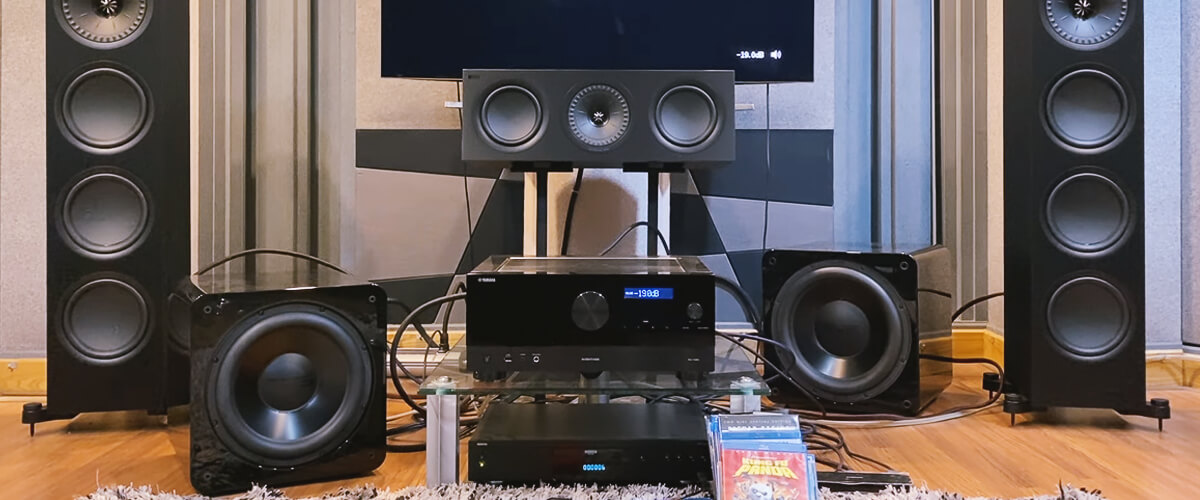
When shopping for an AV receiver in the sub-$1000 price range, you’ll find various useful features that enhance your home theater experience. Let’s look at some key aspects to expect from a quality AV receiver at this price point.
Power Output
In my experience, a decent AV receiver under $1000 should provide sufficient power output to drive your speakers and deliver an immersive audio experience. Aim for a receiver that offers around 80 to 100 watts per channel, which I’ve found enough to fill most living rooms with crisp, dynamic sound.
Wireless Streaming
We all know how important wireless streaming capabilities are in today’s connected world. While testing AV receivers in this price range, I’ve noticed that most of them offer built-in Wi-Fi and Bluetooth, allowing you to stream music easily from your smartphone or other devices. Some models even support popular streaming services like Spotify, Tidal, or Apple Music, making it super convenient to enjoy your favorite tunes.
Multi-room Audio
Multi-room audio functionality is one feature I’ve always appreciated in AV receivers under $1000. It allows you to connect multiple speakers and control them independently throughout your home, creating a seamless audio experience across different rooms. From my experience, I recommend looking for receivers that support popular multi-room audio platforms like HEOS, MusicCast, or Play-Fi for optimal compatibility and user experience.
Voice Control
As smart home technology continues to gain popularity, voice control has become an increasingly common feature in AV receivers. Many models in the sub-$1000 price range offer compatibility with popular voice assistants like Amazon Alexa, Google Assistant, or Apple Siri. I love controlling various aspects of my home theater system, such as volume, input selection, and even playback, using just my voice.
Reasons to upgrade to the higher-end AV receiver
I understand the temptation to upgrade to a higher-class receiver. From my experience, there are several reasons why you might consider taking that step. Let’s look at them together and see if upgrading is right for you.
| Feature | Benefit |
|---|---|
| Higher Power Output | A pricier receiver often provides more power output per channel, allowing you to power larger or more demanding speakers. |
| Advanced Audio Codecs | A higher-end receiver typically supports advanced audio codecs offering a more immersive audio experience. |
| Video Upscaling | Built-in video upscaling capabilities in more expensive receivers can enhance standard-definition content. If picture quality is a priority, this is a valuable feature. |
| More Connectivity Options | With additional HDMI inputs or Ethernet ports, a pricier receiver enables you to connect more devices to your home theater system, making it more versatile and future-proof. |
| Multi-room Audio Support | If you’re keen on playing different audio content in various rooms, you’ll appreciate the multi-room audio support found in higher-end receivers. |
| Advanced Room Correction | More expensive receivers often include advanced room correction software, optimizing audio output based on your room’s acoustic properties for a tailored experience. |
| Better Build Quality | A higher-quality build, using better materials and components, results in a more robust and durable product that can last for years. |
| Improved Soundstage | A higher-end receiver delivers a wider and more precise soundstage, allowing for accurate placement and differentiation between audio elements in movies and music. |
| Better Amplifier Circuitry | Advanced amplifier circuitry in pricier receivers provides a cleaner and more accurate audio signal, revealing more details and nuances in your content. |
| More Customization Options | Higher-end receivers offer more customization options for audio and video settings, letting you fine-tune your home theater system to your preferences. |
| Enhanced Streaming | With support for advanced streaming capabilities like Hi-Res audio streaming or streaming from a wider range of sources, a higher-end receiver adds versatility to your system. |
So, upgrading to a higher-class AV receiver can provide many benefits. I can attest that such an upgrade can transform your home theater. But first, evaluate your needs and financial capabilities and decide if it’s really time to upgrade your system.
FAQ
Do I need to upgrade my speakers if I upgrade to a more expensive AV receiver?
Can I use a $1000 AV receiver for gaming as well as movie and music playback?
How do I know if an AVR is future-proofed to support new technologies and formats as they are released?
HDMI Inputs: Ensure your AV receiver has enough HDMI inputs to support your current devices and any future additions. Look for HDMI 2.1 ports, which support 4K/120Hz and 8K/60Hz, along with other advanced features like Variable Refresh Rate (VRR) and Auto Low Latency Mode (ALLM).
eARC Support: Enhanced Audio Return Channel (eARC) is a feature that allows your TV to send high-quality audio back to the AV receiver.
Wireless Connectivity: Look for built-in Wi-Fi and Bluetooth support, allowing you to stream music from your phone or other devices and receive firmware updates that can add new features and improve performance.
Support for Advanced 3D Formats: Ensure your AV receiver supports the latest surround sound formats, such as Dolby Atmos, DTS:X, and Auro-3D, to take advantage of immersive 3D audio experiences fully.




![Best 2-Channel Receiver [Expert Reviews and Buying Guide]](https://hometheaterology.com/wp-content/uploads/2023/11/best-2-channel-receiver-stereo-300x150.jpg)


